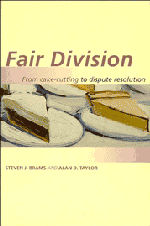Book contents
- Frontmatter
- Contents
- List of figures
- List of tables
- Acknowledgments
- Introduction
- 1 Proportionality for n = 2
- 2 Proportionality for n > 2: the divisible case
- 3 Proportionality for n > 2: the indivisible case
- 4 Envy-freeness and equitability for n = 2
- 5 Applications of the point-allocation procedures
- 6 Envy-free procedures for n = 3 and n = 4
- 7 Envy-free procedures for arbitrary n
- 8 Divide-the-dollar
- 9 Fair division by auctions
- 10 Fair division by elections
- 11 Conclusions
- Glossary
- Bibliography
- Index
4 - Envy-freeness and equitability for n = 2
Published online by Cambridge University Press: 05 July 2011
- Frontmatter
- Contents
- List of figures
- List of tables
- Acknowledgments
- Introduction
- 1 Proportionality for n = 2
- 2 Proportionality for n > 2: the divisible case
- 3 Proportionality for n > 2: the indivisible case
- 4 Envy-freeness and equitability for n = 2
- 5 Applications of the point-allocation procedures
- 6 Envy-free procedures for n = 3 and n = 4
- 7 Envy-free procedures for arbitrary n
- 8 Divide-the-dollar
- 9 Fair division by auctions
- 10 Fair division by elections
- 11 Conclusions
- Glossary
- Bibliography
- Index
Summary
Introduction
As we saw in chapters 2 and 3, proportional fair-division procedures do not generally produce efficient fair divisions, even in the two-person case (Knaster's procedure, described in section 3.2, is an exception). The same will turn out to be true for several envy-free procedures we will describe in chapters 6 and 7. In this chapter, however, we will show that envy-freeness and efficiency need not be incompatible, at least when there are only two players.
The framework we use, however, is very different from that of the previous chapters. Instead of starting with a heterogeneous cake or set of indivisible items, we begin with k discrete goods (or issues), each of which we assume is divisible. It is these that must be divided between two players.
In this new context, the two players explicitly indicate how much they value each of the different goods by distributing 100 points across the goods. This information, which may or may not be made public, becomes the basis for making a fair division of the goods.
Valuations in cake division, by contrast, are implicit in the procedures used. They determine how the players divide a cake into equal pieces, which ones they judge to be acceptable, and so on. But the players are never required to say explicitly how much they value the different parts of the cake.
- Type
- Chapter
- Information
- Fair DivisionFrom Cake-Cutting to Dispute Resolution, pp. 65 - 94Publisher: Cambridge University PressPrint publication year: 1996



